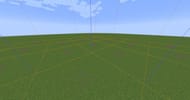Minecraft players have likely seen the term thousands of times via loading screens and the F3 menu, but what are chunks exactly, and how large are they?
Put plainly, a chunk is a 256-block tall, 16x16 block segment of a Minecraft world. They are used by the game's world generation code to break the game world into segments that are easier to map out for the game engine. In total, chunks measure in at 65,536 blocks. Compared to the 30 million blocks in each direction of a game world, it may seem small, but chunks effectively make up the foundation of any Minecraft seed.
Chart New Territories with the ultimate Minecraft Seed Generator!
Minecraft: Other info about chunks

Information about chunks, how they generate, their comprisal and more is a heavily technical topic. However, there are some baseline facts about chunks that can be helpful for Minecraft players, especially those looking to implement certain mods. There's a lot to process about the way chunks load, but it essentially comes down to a few things:
- Since there are a massive number of chunks and blocks in a Minecraft world, in order to save processing and graphical rendering power, the game only renders chunks immediately around the player based on the render distance setting. At a low render distance setting, this can be seen by travelling. The popping in of things such as land, water, trees and mobs is what the game's rendering is making available to the player. Other chunks remain unloaded until they are needed in order to avoid processor load problems.
- There is a mechanic known as a ticket that handles chunk loading. All chunks loading into the game for the player come from this ticket. Each ticket has three properties which are ticket type, time to live (optionally) and ticket level. Without diving too much into it, these tickets decide what kind of chunk is generated (standard or exiting a Nether Portal for example) and if it is accessible to the player or not or whether certain mechanics such as Redstone apply to them.
- Mobs spawning is decided by each chunk within a six chunk cylindrical radius of those that the player has loaded in.
- Chunks have "edges" which can be detected by their coordinates. Since chunks are 16x16 in dimension, X and Z coordinates that are divisible by 16 are the boundaries of a given chunk.
There are tons of more facts about chunks that dive heavily into the aspects of chunk interactions and limitations as well as how they interact within the game code's framework for Java and Bedrock editions. With so much to know about chunks, players that have the drive to learn more won't lack information in the slightest.
Read More: 5 best Minecraft texture packs in 2021
Uncover new worlds with our Minecraft Seed Generator!

